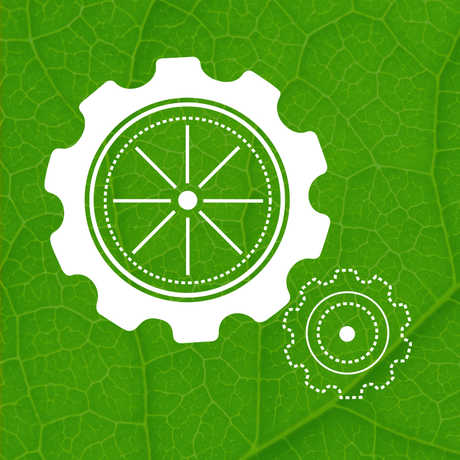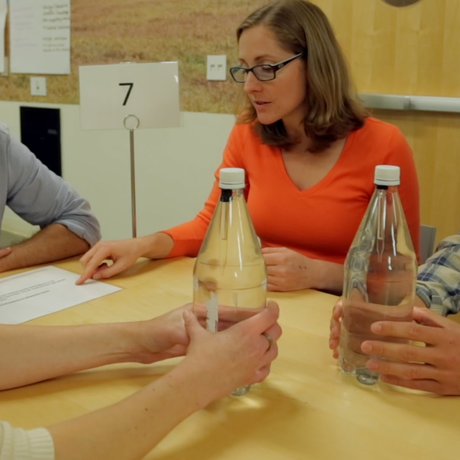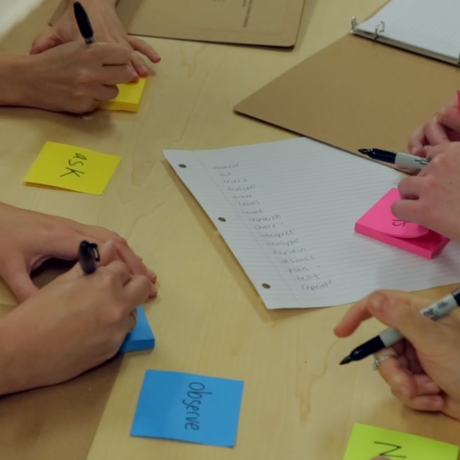
The prominent inclusion of engineering concepts throughout the NGSS presents a new challenge for many science educators. Comparing the Science and Engineering Practices explores how the practices are used in in these two fields. Participants will work in groups to compare and contrast the practices in a science versus engineering context. Each group will create a poster and share key points in a brief presentation. Participants leave this activity feeling more comfortable with the idea of bringing aspects of engineering into their science teaching.
Watch the video above to get an overview, and use the detailed lesson plan below to lead this professional development activity for your team of educators.
Learning Goals
Participants in this activity will
- compare and contrast the Science and Engineering Practices (SEPs).
- discover how science and engineering are similar and different.
- analyze some of the NGSS language defining the SEPs.
Approximate Time
- Full version: 50 minutes
- Split version: two 30-minute sessions
- Abbreviated Version: 35 minutes
Materials
- Science and Engineering Practice comparisons handouts 1-8 (1 Practice per group, 1 handout per participant)
- Science and Engineering comparisons notes tool (1 per participant)
- Large easel paper/chart paper (1 sheet per group, 8 total)
- Scratch paper
- Markers
- (Optional) Appendix F from the NGSS
Prepare
- Print handouts: Comparisons, notes tool, and any optional handouts desired.
- Gather all other materials.
- Write directions for Part 1 poster creation on a whiteboard or poster, or create a presentation slide.
- Abbreviated version: Draw the table (shown on page 5 of the activity plan) on the whiteboard or a poster.
Facilitator Background
The prominent inclusion of engineering concepts throughout the NGSS is a challenging part of the new standards for many educators. This activity further explores the Science and Engineering Practices (SEPs) as they are used in both science and engineering, using as a tool Box 3.2 from A Framework for K-12 Science Education (50-53).
The tools and techniques of science and engineering overlap in many ways, but there are some fundamental differences in how engineers use them versus how scientists do. One main distinction is purpose. In general, the goal of engineering is to solve problems, while the goal of science is to explain natural phenomena. The two practices that highlight this contrast are “Asking Questions (science) and Defining Problems (engineering)” and “Constructing Explanations (science) and Designing Solutions (engineering).” Other practices are used similarly by scientists and engineers, simply with a different purpose in mind.
In this activity, participants will work in groups to compare and contrast the practices in a science versus engineering context. Each group will create a poster and share key differences and/or similarities with an “elevator speech” style presentation. An “elevator speech” sums up an idea very quickly—in about 60 seconds—the logic being that you could share a full idea with someone you happen to meet on a short elevator ride. Requiring a short-and-sweet presentation keeps this activity rolling and the energy level high!
Full Version
Part 1: Science and Engineering Practices Comparisons (25 minutes)
- Introduce the goal of the activity: to analyze and briefly present how one practice is similar and/or different in science and engineering.
- Split the class into eight small groups and give each group one of the Science and Engineering Practices comparisons. If you have a small class (less than 16 participants), split them instead into four groups and give each group two practices to explore.
- Ask participants to read their comparison individually (about 5 minutes).
- Give groups time to discuss the comparison (about 5 minutes).
- Give instructions for creating and presenting a poster that summarizes how similar and/or different the practice is in science and engineering. Share the poster instructions visually on a whiteboard, poster, or presentation slide (see example on page 2 of the Activity Plan).
- Give groups 15 minutes to create their posters. Advise them to start by making a rough draft to sort out their ideas.
- About halfway through the 15 minutes, remind groups to begin creating their final posters, and announce the time when poster presentations will begin.
Part 2: Poster Presentations (20 minutes)
- Distribute the “Science and Engineering Comparisons notes tool.” Explain that they can use this to take notes during the poster presentations.
- Have each group present their poster, “elevator speech” style. Depending on time limitations, you may want to use a timer and hold strictly to a 60 – 90 second time limit for each speech.
- Pause and ask for any thoughts, comments, or questions after each poster presentation—about 60 additional seconds per presentation.
Part 3: Group Discussion (5 minutes)
- Lead a whole group discussion to synthesize ideas from the poster presentations. Discussion questions and talking points may include:
- How are science and engineering similar and different?
- While science begins with asking questions, engineering begins with defining a problem to solve.
- The goal of science is to construct explanations for phenomena.
- The goal of engineering is to solve problems.
- Which practices are the most clearly different in science and engineering?
- Asking Questions is a scientific practice and Defining Problems is an engineering practice.
- Similarly, Constructing Explanations is a scientific practice and Designing Solutions is an engineering practice.
- How might the differences and similarities across the two disciplines show up in classroom activities?
- This could lead to a discussion about the possibility of shifting existing science lessons to an engineering lens by reframing questions as problems.
- Participants may also share their own experience with engineering and/or design thinking in their classrooms.
- How are science and engineering similar and different?
Make sure participants leave activity with these key messages:
- The Science and Engineering practices are very similar and overlap in many ways across both science and engineering.
- There are 2 practices that are clearly different for science compared to engineering: Asking Questions (science) and Defining Problems (engineering) and Constructing Explanation (science) and Designing solutions (engineering).
Split Version
In this version, poster-making and elevator speeches are in two different sessions. Some adjustments are suggested here.
- Session 1 [30 minutes]: Do Part 1 (Science and Engineering Comparisons) as described above. Advise participants that elevator speeches will be done in the next session, and include 5 additional minutes at the end of Part 1 for participants to jot down notes that will help them remember important points they want to include in their elevator speech/poster presentation in the next session.
- Session 2 [30 minutes]: Before beginning Part 2 (Poster Presentations), give participants about 5 minutes to review their posters and the notes they made at the end of Session 1. Do Part 2 and Part 3 (Discussion) as described above.
Abbreviated Version
If you need to shorten this activity to fit the time you have available, we recommend spending less time on Part 1 by removing the poster component, and adding a table where the facilitator can take public notes to focus on key points during the discussion.
Part 1: Comparing and Preparing (10 minutes)
- Introduce the goal of the activity: to give an “elevator speech” (60-90 seconds!) summarizing the comparison of one practice in the context of science vs. engineering.
- Split the class into eight small groups and give each group one of the eight Science and Engineering Practice comparisons. If you have a small class (less than 16 participants), split them instead into four groups and give each group two practices to explore.
- Ask participants to read their comparison individually (about 2 minutes).
- Give groups time to discuss the comparison and prepare their “elevator speech” (about 7 minutes).
Part 2: Elevator Speeches (20 minutes)
- Distribute the “Science and Engineering Comparisons notes tool.” Explain that they can use this to take notes during the presentations.
- Have each group present their comparison. Depending on time limitations, you may want to hold strictly to a 60 – 90 second time limit for each speech, using a timer to keep things rolling.
- Pause and ask for any thoughts, comments, or questions after each presentation (about 60 seconds per presentation).
- During elevator speeches and follow-up conversations, take notes on the board in a prepped table (see page 5 of the activity plan) to collect main ideas. (This replaces the role of the posters as a visual aid.)
Part 3: Group Discussion (5 minutes)
- Lead a short whole-group discussion similar to the Full Version, using the notes recorded in the table during the presentations to help pull out the Key Messages.

NGSS Demystified
This training toolkit will prepare you to lead PD for other educators.
Browse all of the videos at once.

